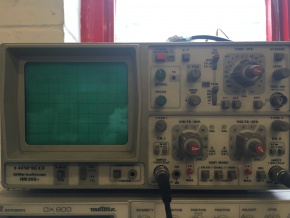Electronics/HM203-7: Difference between revisions
No edit summary |
No edit summary |
||
| Line 42: | Line 42: | ||
Unless you are very experienced with an oscilloscope then it is not advisable to probe high voltages or high power sources. It is possible to electrocute yourself or damage the oscilloscope. Special oscilloscope probes and specific connection methods are needed for probing high voltage and mains electricity signals. The oscilloscopes are replaceable, you are not! We want you to be safe. | Unless you are very experienced with an oscilloscope then it is not advisable to probe high voltages or high power sources. It is possible to electrocute yourself or damage the oscilloscope. Special oscilloscope probes and specific connection methods are needed for probing high voltage and mains electricity signals. The oscilloscopes are replaceable, you are not! We want you to be safe. | ||
Usully an oscilloscope ground it connected to mains earth. See the EEV blog #279 video for information on how not to blow up your oscilloscope. | |||
Oscilloscopes can be heavy instruments. Bend at the knees when lifting and ask for help if you find the instrument too heavy to move. | Oscilloscopes can be heavy instruments. Bend at the knees when lifting and ask for help if you find the instrument too heavy to move. | ||
Do not leave oscilloscope probes (or anything) hanging over the edge of a bench or on the floor. | Do not leave oscilloscope probes (or anything) hanging over the edge of a bench or on the floor. They can be tripped over, stood on or knock off the bench. | ||
== Useful References == | == Useful References == | ||
Revision as of 15:17, 3 April 2016
 | |
| Analogue oscilloscope | |
| Equipment Information | |
|---|---|
| Status | Unknown |
| Manufacturer | Hameg |
| Model | HM203-7 |
| Hackspace Information | |
| Induction Required | Yes |
| Induction Information | Here |
| Card RFID Enabled | No |
| Owner | Hackspace & Members & Fligg |
| [More Info] | |
The Basics
An oscilloscope is a piece of electrical test equipment which allows you to visually see an electrical signal shown on a display. We have two Hameg HM203-7 oscilloscopes at the hackspace.
Specification
A basic oscilloscope specification is given below:
- Analogue Cathode ray tube (CRT)
- Bandwidth: 20MHz
- 2 channel + Ext trigger (2.5:1 to 12.5v/div)
- 5v to 5mv vertical (x5 giving 1mv sensitivity)
- 100ms to 0.2us horizontal (x10 to give 20ns/div)
- Component tester
- X-Y mode for Lissajous figure and drawing funny images with audio!
- Scope 1 issues: [31 March 2016] Functional. CH1 10% low on vertical, CH2 10% low on vertical, Horizontal about 5% high, confirmed against cal point and a precision v ref.
- Scope 2 Issues: [31 March 2016] Functional. CH1 10% low on vertical, CH2 10% low on vertical, Horizontal about 5% low, confirmed against cal point and a precision v ref.
- Manual TBD
- Owner: Fligg, labelled scope 1
- Owner: TBD, labelled scope 2
Calibration
The spaces oscilloscopes will NOT normally have a calibration certificate. Most will be well outside their calibration date. Having said that it is common to perform a basic oscilloscopes calibration check before each use against a known calibration source to confirm it is suitable for use. Most oscilloscopes have a calibration signal output point on the front panel. Some have rear panel outputs.
Induction
Ask on the mailing list for volunteers to demonstrate the use of any of the test equipment.
Safety
Unless you are very experienced with an oscilloscope then it is not advisable to probe high voltages or high power sources. It is possible to electrocute yourself or damage the oscilloscope. Special oscilloscope probes and specific connection methods are needed for probing high voltage and mains electricity signals. The oscilloscopes are replaceable, you are not! We want you to be safe.
Usully an oscilloscope ground it connected to mains earth. See the EEV blog #279 video for information on how not to blow up your oscilloscope.
Oscilloscopes can be heavy instruments. Bend at the knees when lifting and ask for help if you find the instrument too heavy to move.
Do not leave oscilloscope probes (or anything) hanging over the edge of a bench or on the floor. They can be tripped over, stood on or knock off the bench.